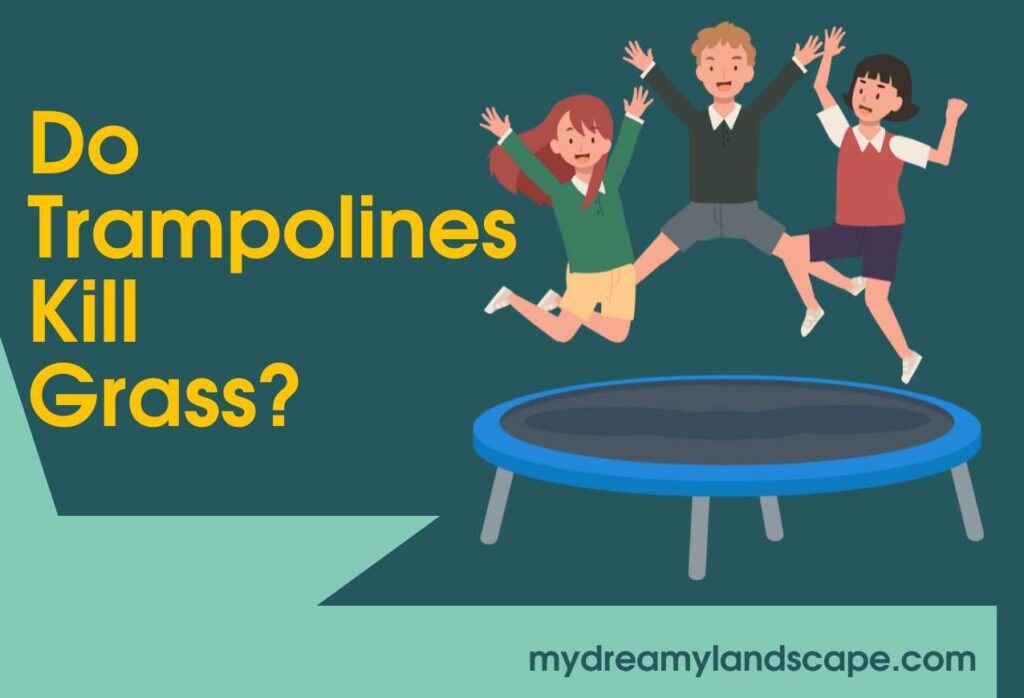Can a trampoline kill grass? In suburban backyards, the joy of trampoline bouncing is often accompanied by concerns about potential harm to the lush green carpet below. Homeowners fear that trampolines may have a detrimental impact on grass health, sparking questions and misconceptions.
This article discusses the root of these worries, exploring the interaction between trampolines and lawns. Let’s get started.
Do Trampolines Kill Grass?
Trampolines typically do not “kill” grass outright, but their presence can have varying effects on lawns, depending on factors like design, maintenance, and grass type. The potential for grass damage arises from factors such as the weight of the trampoline, reduced sunlight penetration, inhibited airflow, and constant foot traffic.
However, with proper placement, maintenance, and protective measures, homeowners can minimize the negative impacts caused by trampolines on grass. We will explain all in detail later in the article.
How do I Keep My Trampoline From Killing the Grass?
To prevent your trampoline from negatively affecting your grass, we recommend following these preventive methods:
Optimal Placement
-
- Place your trampoline on a flat, well-drained area to minimize stress on the grass.
- Ensure adequate spacing from trees, structures, and other potential obstructions.
Regular Relocation
-
- Periodically relocate the trampoline to allow grass recovery underneath.
- This prevents prolonged pressure on specific areas and promotes even grass growth.
Use Ground Covers
-
- Lay down ground covers or permeable materials beneath the trampoline.
- These covers protect the grass from direct contact and reduce wear and tear.
Rotate Trampoline Position
-
- Rotate the trampoline’s position in your yard occasionally.
- This helps distribute the impact on different sections of the lawn.
Implement Aeration
-
- Aerate the soil beneath and around the trampoline to enhance grass root health.
- Aerating improves air and water penetration, mitigating potential compaction.
Proper Maintenance
-
- Trim grass regularly around the trampoline to prevent overgrowth.
- Maintain a consistent lawn care routine, including watering and fertilizing.
Protective Platforms
-
- Consider placing a protective platform or rubber mat beneath the trampoline.
- These platforms act as a barrier, shielding the grass from direct contact.
Monitor Soil Health
-
- Keep an eye on the soil’s health under the trampoline.
- Ensure proper drainage, and address any signs of compaction or nutrient deficiencies.
Which Parts of Trampolines Come into Contact With the Grass?
When you set up a trampoline, various parts come into contact with the grass. The frame, legs, and springs are the primary components that may touch the ground. The frame is usually made of metal and is in direct contact with the grass surface.
Additionally, the legs, often made of steel or other materials, provide support and may also impact the grass beneath. Springs connect the jumping surface to the frame, and their placement can influence the overall pressure on the lawn. Being aware of how these components interact with the grass helps you make informed decisions about trampoline placement and potential lawn impact.
Are Certain Types of Grass More Resilient to the Presence of Trampolines?
Yes, certain types of grass are generally more resilient to the presence of trampolines and the associated foot traffic. Here are some grass varieties we identified for their resilience.
Zoysia Grass
Known for its dense and tough turf, Zoysia grass is highly resilient to foot traffic and recovers well from stress.
Bermuda Grass
Bermuda grass is durable and able to withstand heavy use. It’s commonly used in sports fields and high-traffic areas.
Kentucky Bluegrass
Kentucky Bluegrass is known for its fine texture and ability to recover quickly from stress, making it suitable for moderate foot traffic.
Perennial Ryegrass
Perennial Ryegrass establishes quickly and has good wear tolerance, making it a suitable option for lawns with increased foot activity.
Fescue Varieties
Fine Fescue varieties, such as creeping red fescue, are known for their fine texture and adaptability to various conditions, including moderate foot traffic.
Should Trampolines be on Grass or Patio?
Whether to place your trampoline on grass or a patio depends on various factors, and your decision should align with your preferences and considerations. Let us explain advantages and what you should consider whether to place your trampoline on grass or patio.
On Grass
Advantages
-
- Natural Feel: Placing the trampoline on grass provides a natural and softer surface for jumping.
- Ground Absorption: Grass can absorb some impact, potentially reducing stress on the trampoline components.
Considerations
-
- Lawn Health: Ensure your grass is resilient and well-maintained to withstand the trampoline’s presence.
- Drainage: Choose a well-drained area to prevent water accumulation beneath the trampoline.
On Patio
Advantages
-
- Stability: Patios offer a stable and flat surface, enhancing the trampoline’s stability during use.
- Easy Maintenance: Patios require less maintenance compared to grass, reducing potential lawn care concerns.
Considerations
-
- Surface Impact: The patio surface can be harsher on the trampoline components, potentially leading to wear and tear.
- Safety: Ensure the patio is large enough and clear of obstacles to accommodate the trampoline safely.
If you or your family prefer the feel of jumping on grass, that may influence your decision. Conversely, if stability and ease of maintenance are priorities, a patio setting could be more suitable.

